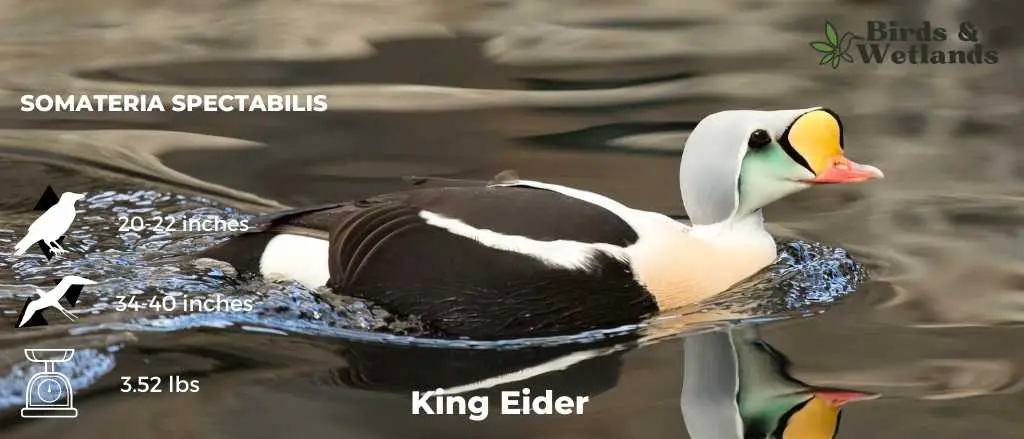The king eider (Somateria spectabilis) is a large sea duck that spends most of its time in coastal environments at high latitudes. It breeds in the Arctic and sub-Arctic regions of North America, Asia and Europe.
Scientific Name: Somateria spectabilis
Height: 52–57 cm (20–22 inches)
Wingspan: 86–102 cm (34–40 in)
Weight: 1.6 kg
King Eider Description
Adult males in breeding plumage have a striking appearance. They have a pale powder blue crown and nape and pale green cheeks. Its red bill with a white nail is separated from the face by a thin black line.
The head of male king eiders rests atop a black body, tail and rump. The white mantle, breast and flanks contrast sharply with the black upperwing, with conspicuous white greater and median wing coverts. The tertials are curved, forming spurs along the back. They also have a white patch at the base of their tails.
The female king eider is a striking bird with washed, mottled brown plumage and conspicuous dark streaks on the crown and nape. It has a whitish area at the base of its dark bill, and a narrow white line separates its streaked dark brown upper parts and flanks.
Females are slightly smaller than males, with a shorter bill and less extensive white markings.
The juvenile king eider is mostly grey with some brownish tones on the back. The bill is dark, and the head and neck are a duller grey than the rest of the body.
Juveniles are also more mottled than adult females, with lighter and darker areas creating a patchy appearance. This plumage lasts until the third winter.
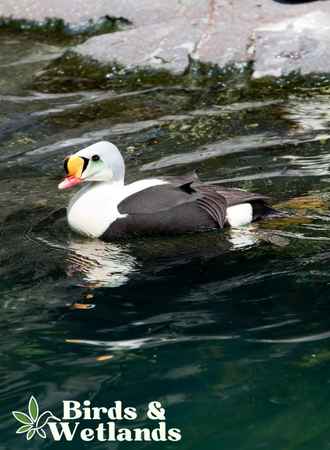
Listen to King Eider
The most common sound made by males is a gentle “ruur” call, similar to a dove’s sound. Both males and females also make a low “kwak” noise when alarmed, along with growling, croaking, grunting, and murmuring sounds.
Interestingly, the modified scapular feathers on the back of adult males can make a vibrating noise when they land on water.
King Eider Habitat & Range
The king eider is a circumpolar species that live all over the high Arctic. It nests in both wet and dry tundra habitats, usually near bodies of water, whether interior lakes or the ocean coast.
The king eider breeds along the Arctic coasts of Canada, northern Alaska, Greenland, Svalbard and Russia.
The king eider can raise its young in both fresh water and saltwater environments. Once young king eiders fledge, they migrate with their parents to saltwater habitats.
During the winter, most king eiders migrate to sub-Arctic marine areas along the coast of the Bering Sea, the west coast of Greenland, the east coast of Canada and southern parts of Norway. Some flocks spend wintes along the Great Lakes.
Some king eiders congregate with other birds such as common eiders and long-tailed ducks.
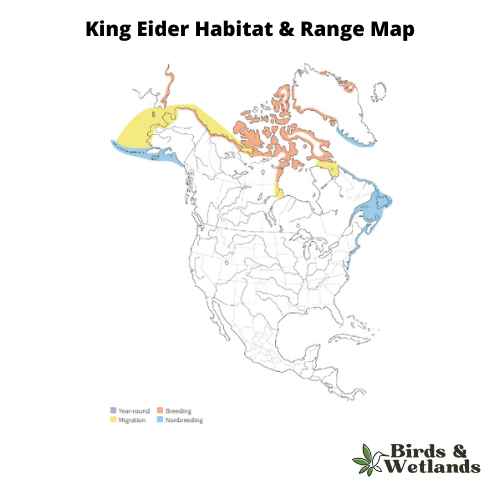
King Eider Diet & Food Habits
King eiders are proficient divers that feed primarily on aquatic insects, mollusks, insect larvae, crustaceans and benthic invertebrates. They eat king crabs, sea urchins, starfish and sea anemones.
These sea ducks are expert divers who dive as deep as 60 feet to search for food on the sea floor. To help them with this, they have special adaptations such as webbed feet, waterproof plumage, and a network of blood vessels that helps to keep them warm in cold water.
Moreover, the King Eider, like most diving ducks, has evolved a large supraorbital process to protect its eyes and salt glands while foraging on the ocean floor.
King eiders have powerful beaks, which they use to pry open shellfish and break through hard exoskeletons.
During the breeding season, king eiders dive less underwater and dabble more in freshwater lakes and ponds. They pluck aquatic invertebrates from the water’s surface.
On occasion, king eiders consume aquatic plants and algae to supplement their diet.
King Eider Common Behaviors
The king eider is a gregarious duck that breeds during the summer in isolated pairs. The male performs a series of ritualized displays, such as rearing up out of the water with flapping wings, accompanied by cooing calls, to attract a mate.
If the female does not accept these displays, she may chase the male away. During these movements, the male puffs up its chest and stretches its wings.
During the non-breeding season, king eiders gather in large flocks. They can often be seen resting on open water in small groups or larger rafts.
King eiders may be slow and cumbersome but can take off rapidly from the water. This is partly due to their heavy bodies and large wingspan. They are more agile than the common eider.
King eiders also depend on their strong vision to watch for predators. These birds are alert and wary of threats, quickly taking flight if disturbed. They may even join large flocks of other sea ducks to enhance their protection against potential predators.
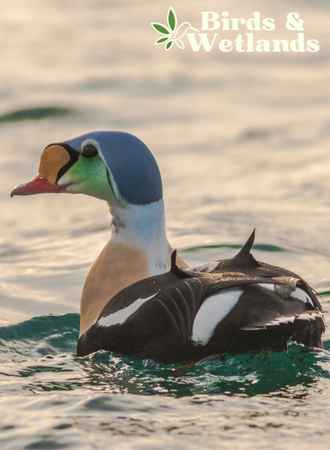
King Eider Nesting & Mating Habits
Spring migration begins in early April, with flocks moving north over mostly frozen sea ice.
King eider pairs form during spring migration or on the breeding grounds. Several males may surround a female during courtship displays and try to attract her attention.
Female king eiders select a nest site near the water. Nests are typically shallow depressions lined with plant material such as grasses, mosses, and large amounts of down feathers for insulation.
After successfully mating, one female lays a clutch of 2 to 7 pale olive eggs, which she incubates for 22 to 23 days. During incubation, the adult male leaves the female and molts along the nearby coast.
Young king eiders are born precocial and leave the nest within 24 hours from hatching. Ducklings are raised collectively by several adult females. They reach sexual maturity at three years old.
Once the young king eiders have fledged, female eiders will lead them to saltwater areas. Here, the young birds learn to dive for food and gain independence from their mothers.
King eiders have a lifespan of up to 15 years in the wild. The oldest living king eider ever recorded was a female who lived for 18 years until it was shot in 1958.
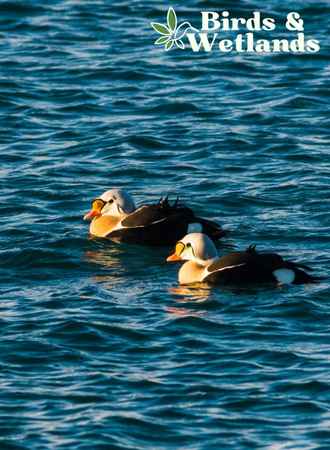
King Eider Population & Conservation Status
The king eider is listed as a species of “Least Concern” by the IUCN (International Union for Conservation of Nature) due to its very large range.
However, certain threats may affect their population. These include overfishing, oil spills, and climate change. In addition, illegal hunting and predation can pose a significant risk to these birds.
Conservation efforts are in place to protect king eiders by using protected areas and managing hunting levels. Furthermore, education programs can help raise awareness about the importance of protecting this species.

King Eider Hunting
Hunting king eiders is legal in the United States. These ducks are popular game birds throughout the country, particularly in Alaska, where they are plentiful.
To hunt king eiders, a hunter must have a valid hunting license and follow the regulations of the state in which they are hunting.
King eiders are an important source of food for many people. They are considered a delicacy, and their meat is prized for its flavor. Some people also use their feathers and down for bedding and insulation.
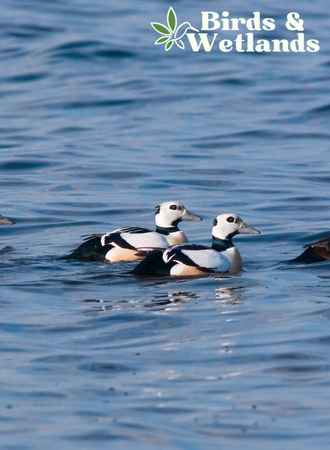
Key Points
- The king eider is a large sea duck that spends most of its time in coastal environments at high latitudes.
- It breeds along the rocky coasts and coastal areas of Alaska and the Hudson Bay.
- Adult males have a pale powder blue crown and nape, with pale green cheeks.
- A breeding male has a black body, tail and rump.
- Adult females and young males are washed tawny brown plumage with conspicuous dark streaks on the crown and nape.
- Juveniles are mostly grey with some brownish tones on their back. The plumage lasts until the third winter. They also have an orange bill.
- King eiders forage in the seas and oceans, often diving underwater to search for krill, squid and shellfish.

